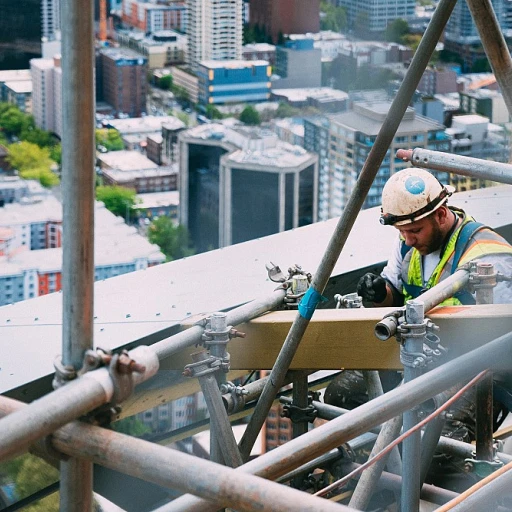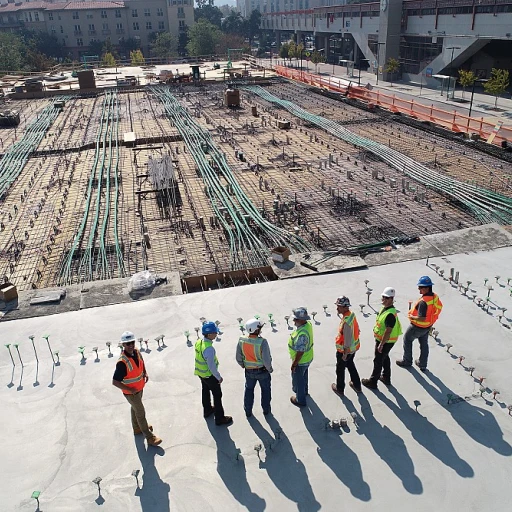The Rise of Smart Office Technologies
The Emergence of Innovative Office Technologies
The transformation of our work environments with innovative office technologies is shaping not just the physical office but the way we interact, collaborate, and execute our tasks. As we increasingly shift towards digital and connected spaces, these technologies are redefining what it means to work in a modern office environment.
Smart office technologies have become increasingly prevalent, driven by the need for efficiency, collaboration, and flexible work arrangements. From automated lighting systems to sophisticated access control, offices are becoming integrated ecosystems that support dynamic ways of working. This shift is not just about introducing gadgets and systems but about integrating these tools seamlessly to enhance overall productivity and security.
One of the key advancements is the ability to use real-time data and management tools that provide valuable insights into office utilization and employee productivity. These tools enable organizations to adjust their strategies, deploying resources more efficiently while ensuring employee satisfaction and security. As we delve deeper into aspects like smart meeting rooms and burgeoning technologies in office space management, it is clear that the potential of digital workplace tools is immense. For more on this significant evolution, explore the unlocking of the potential of digital workplace tools
here.
The rise of these technologies promises to set new standards in office architecture and management, compelling us to rethink traditional office setups entirely. With this ongoing evolution, businesses are continually reassessing how these technologies can be best harnessed to create environments that are not only intelligent but also conducive to the well-being and productivity of all employees.
Smart Meeting Rooms: More Than Just Video Conferencing
Transforming Collaboration: Beyond Traditional Video Conferencing
In the evolving landscape of advanced office solutions, smart meeting rooms have become a crucial element in fostering collaboration that goes far beyond traditional boundaries. While video conferencing has long been a staple for remote communication, the incorporation of smart technology into meeting spaces is revolutionizing the way we interact and collaborate.
One of the most significant advancements is the integration of AI-driven tools that enhance communication by providing real-time transcription services, language translation, and even sentiment analysis to offer insights during discussions. Smart cameras and microphones tailor themselves to participant dynamics, ensuring that everyone in the room or joining remotely is heard clearly and seen effectively.
Furthermore, these smart settings are now equipped to support collaborative work with modern digital whiteboards and shared screens, allowing seamless content sharing and brainstorming, no matter where the team members are located. The ability to save and review meeting notes afterward enhances productivity and keeps the team aligned toward common goals.
Integrating these technologies does more than streamline meetings; it addresses common challenges associated with remote work, like maintaining engagement and ensuring every voice is heard. As businesses continue to redefine what the future of work looks like, smart meeting rooms prove to be essential in shaping productive and inclusive work environments. Learn more about how these changes are impacting the
future of the modern office and reshaping traditional workspace dynamics for greater efficiency and creativity.
Enhancing Office Space with Smart Lighting and Climate Control
Transforming Workspaces with Smart Lighting and Climate Control
In today's ever-evolving work environment, the emphasis on creating efficient and comfortable office spaces has never been more important. As companies increasingly invest in state-of-the-art technology to enhance productivity and employee satisfaction, the integration of smart lighting and climate control systems is becoming a game-changer.
Smart lighting systems offer the ability to adjust brightness and light color to match the time of day or the specific needs of a task. By synchronizing with natural daylight or task-specific settings, these systems can significantly enhance employee comfort and well-being, reducing eye strain and fatigue.
Moreover, smart lighting systems are often equipped with motion sensors, automatically adjusting based on occupancy. This not only ensures energy efficiency but also fosters an environment that feels responsive and adaptive to the immediate needs of those working within it.
Climate control is another vital aspect that is undergoing a smart transformation. Traditional HVAC systems can be replaced or augmented by intelligent climate controls that can be managed remotely and tailored to individual preferences or seasonal variations. By monitoring air quality, temperature, and humidity, these systems can significantly improve workplace comfort.
Furthermore, integrating smart lighting and climate control creates substantial energy savings and reduces operational costs. The capability to gather data on usage patterns allows for better resource management and sustainability practices, ultimately aligning with a more environmentally-conscious corporate ethos.
The digital transformation of workspaces further delves into the role of these automated systems in crafting an optimal working environment. As discussed in previous sections, modern technology is redefining how we approach office design and functionality. The transition to a smart office is not merely about installing new devices; it involves a holistic integration of technology that reflects the broader trend of reshaping how and where we work. For a deeper exploration of the technologies reshaping the workplace, visit
how digital transformation is shaping the modern workplace.
While the advantages of smart lighting and climate control are manifold, challenges such as initial installation costs and the need for ongoing management should not be overlooked. Despite these challenges, the investment often results in a more sustainable and attractive workplace, capable of supporting the well-being and productivity critical to any organization's success.
Access Control Systems: Security in the Smart Office
Redefining Office Security in the Age of Smart Technology
As we move deeper into the era of intelligent office environments, the integration of advanced access control systems is revolutionizing how we perceive security within workplace premises. These systems are no longer just about keeping unauthorized individuals out; they are intricate networks that ensure safety, convenience, and efficiency for employees and organizations alike.
Traditional keys and badges are rapidly becoming relics of the past. Instead, biometric scanners, smart locks, and mobile credentials are setting new standards for securing office buildings. These technologies offer a seamless experience, allowing employees to gain entry to the premises, meeting rooms, and even their personal workspace with minimal friction. By utilizing features such as facial recognition, fingerprint scanning, and smartphone authentication, smart offices enhance the level of security while maintaining a user-friendly approach.
Moreover, these systems provide real-time monitoring and analytics, giving facility managers insights into occupancy patterns and granting the ability to respond promptly to security threats. Imagine an office environment where security protocols can adapt based on the time of day, predetermined high-risk situations, or even specific user profiles. This is not a distant vision but a current reality in the burgeoning world of smart office technology.
However, with these advancements come challenges, particularly concerning privacy and data protection. As office environments adopt complex technologies to safeguard their assets, ensuring that employee data is managed transparently and securely becomes paramount. Navigating these waters requires a fine balance between leveraging the potential of digital control systems and safeguarding individual rights and organizational information.
In conclusion, access control systems in intelligent workplaces represent a significant leap forward in office security, offering both enhanced protection and streamlined processes. As office environments continue to evolve with smart advancements, the security measures they incorporate must also progress to meet new demands and potential vulnerabilities.
Harnessing Real-Time Insights for Efficiency
In today's rapidly evolving work landscape, smart office solutions are not just about automating tasks but also about leveraging real-time data to optimize office operations and enhance productivity. The integration of smart technology within the workplace facilitates unprecedented access to important data, enabling more informed decision-making processes.
With the advent of smart office systems, data collection has become more streamlined, allowing businesses to monitor different aspects of office functionality. Whether it's energy consumption, meeting room utilization, or workspace occupancy, having these insights available in real-time can lead to enhanced operational efficiency. For instance, smart lighting and climate control systems discussed earlier comprise part of a broader network that continuously feeds data back to central management platforms, allowing businesses to adjust settings in real-time for energy savings and employee comfort.
Management tools that incorporate real-time data prove invaluable in planning and resource allocation. Facility managers can analyze patterns and trends, forecasting future requirements with greater accuracy. This can also result in cost savings by reducing waste and optimizing the use of resources. Furthermore, these insights can support health and safety measures within the smart office, providing data that helps to maintain a safe and compliant working environment.
However, alongside these benefits, there are challenges to implementing such technology. Businesses must be prepared to invest in robust data analytics tools and ensure they have adequate cybersecurity measures in place. As the landscape of the smart office continues to evolve, staying informed and adapting to new digital transformations will be key to maintaining a competitive edge in the future of work.
The Benefits and Challenges of Implementing Smart Office Solutions
The Promise and Pitfalls of Smart Office Implementations
As businesses increasingly adopt smart office technologies, it's clear that the benefits are substantial. However, the transition is not without its hurdles. By understanding the advantages and addressing potential challenges, organizations can leverage these innovations effectively.
The benefits are numerous. Smart office solutions, like smart meeting rooms, can streamline collaboration by providing more than just video conferencing capabilities. They enhance productivity by fostering seamless communication and engagement among team members, regardless of their physical location.
Smart lighting and climate control systems offer improved energy efficiency and employee comfort, contributing to a more sustainable and pleasant work environment. Additionally, modern access control systems enhance security, granting authorized personnel access while securing sensitive areas from unwanted intrusions.
Real-time data and management tools provide businesses with valuable insights into operations. These tools facilitate data-driven decision-making, helping companies optimize resource allocation, monitor performance, and proactively address potential issues before they escalate.
Despite these advantages, the implementation of smart office tech presents challenges. Privacy concerns arise as more data is collected and processed, necessitating robust security measures to protect sensitive information. The integration of numerous technologies can also be complex and require significant upfront investment.
Furthermore, the pace of technological advancements demands continual adaptation, which can be resource-intensive. To effectively navigate these challenges, businesses should prioritize a strategic approach to integration, ensuring that technology aligns with organizational goals and employee needs.
As smart offices become the new norm, the key to success lies in balancing innovation with thoughtful implementation. By doing so, companies can create environments that foster productivity, security, and sustainability, ultimately transforming the way we work.














